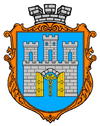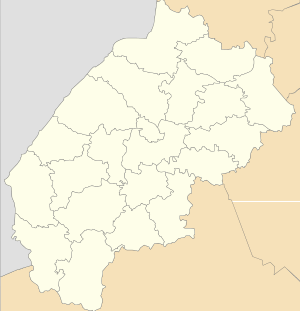Rava-Ruska
Rava-Ruska (Ukrainian: Рава-Руська, translit. Rava-Rus'ka; Polish: Rawa Ruska; Yiddish: ראווע, Rave) is a city in Zhovkva Raion, Lviv Oblast of western Ukraine. It is a border town between Ukraine and Poland. The border checkpoint is situated 8 km (5 mi) west of the city, along the international autoroute Warsaw - Lviv. Its population is approximately 8,647 (2017 est.)[1].
Rava-Ruska Рава-Руська | |
|---|---|
Old town of Rava-Ruska | |
.gif) Flag  Coat of arms | |
 Rava-Ruska Location within Ukraine  Rava-Ruska Rava-Ruska (Ukraine) | |
| Coordinates: 50°13′30″N 23°37′27″E | |
| Country | |
| Oblast | |
| Raion | Zhovkva Raion |
| Founded | 1455 |
| Named for | Rawa Mazowiecka |
| Area | |
| • Total | 8.5 km2 (3.3 sq mi) |
| Elevation | 349 m (1,145 ft) |
| Population (2013) | |
| • Total | 8,426 |
History
Rawa-Ruska was founded in 1455 by the Polish prince Władysław I of Płock, Duke of Bełz and Mazovia, who named the settlement after his regional seat, Rawa Mazowiecka located further west. Due to a convenient location along the merchant trail from Lublin to Lviv, the newly located town quickly developed. For centuries, Rawa was part of the Kingdom of Poland and the Polish-Lithuanian Commonwealth. It remained in private hands of several consecutive szlachta families, such as the Głogowski, Suchodolski, Rzeczycki and Bogusz. In 1622, the town received permission of the King of Poland to organize fairs. In 1672, a skirmish between Polish and Crimean Tatar forces took place here, in which Polish unit under Atanazy Miaczynski freed hundreds of captured peasants. In 1698, Rawa was the site of a meeting between Peter the Great and Augustus the Strong, which led to the Treaty of Preobrazhenskoye in 1699.
From the first partition of Poland in 1772 until the end of World War I in 1918, the town was part of the Austrian Partition ruled first by the Austrian Empire and then by Austria-Hungary after the compromise of 1867. It was a seat of the Rawa Ruska district, one of the 78 Bezirkshauptmannschaften in Austrian Galicia province (Crown land) in 1900.[2] In 1880, its population was 10,500, with 37% Jews, 35% Poles, 20% Germans and 7% Ukrainians. In 1857, Rawa received a rail connection with Jarosław, and next year, the railroad reached Sokal.
20th century
In the early 20th century, Rava-Ruska developed into a rail junction, with a connection to Lviv and Rejowiec, built in 1915. After the rebirth of Poland Rawa-Ruska became part of the Lwów Voivodeship, and the seat of the Powiat Rawski county (area 1,401 km2 (541 sq mi)). The line from to Rejowiec was of leading importance, as it connected the two main cities of Poland, Warsaw, and Lwów. Due to the rail lines, Rawa prospered, and several businesses operated in the town. In 1924, a Belgian company opened here a factory of railroad ties. Furthermore, in the interbellum period Rawa was home to Main School of the Border Guard, which was moved there in 1928 from Góra Kalwaria. The school had a department of training of guard dogs, also located in Rawa-Ruska.
According to Polish census of 1921, the population of the town was approximately 9,000; with 42% Poles, 42% Jews and 14% Ukrainians. By 1938, the population increased to 12,000.
World War II and the Holocaust
On 14 September 1939, during the Invasion of Poland, Rawa-Ruska was captured by the Wehrmacht. The German troops left the town within days in accordance with the German-Soviet Frontier Treaty, and Rava-Ruska was occupied by the Soviet forces. A year and a half later, it was again recaptured by the Germans on the 28 June 1941 during the German invasion of the Soviet Union, Operation Barbarossa. The Ukrainian People's Militia was formed.[3] The town was incorporated into the General Government territory. The Judenrat was established in July 1941.[3] In March 1942 the nearby Belzec extermination camp began its killing operations, and at the end of the month the first transport of 1,000 Jews left Rawa Ruska for Belzec.[3] Many Jewish residents were killed at Belzec in further deportations, usually organized by the Germans and sometimes assisted by the Ukrainian police.[4] [5] Approximately 5,000 Polish Jews from Rava-Ruska were shot during a liquidation Aktion between 7 and 11 December 1942. The last mass shootings of Jews occurred in June 1943, during which 300-400 Jews were killed in a forest outside the village.[6]
After World War II
After World War II, the Polish community of Rava-Ruska was forced to abandon the town and move to the Recovered Territories. Nevertheless, Rava-Ruska remains one of the key centres of the Polish minority in Ukraine, with the local office of the Association of Polish Culture of the Lviv Land operating here.
Transportation
It is located near the border with Poland, opposite the town of Hrebenne. Through the city passes the European route ![]()
Rail station
The city has a railroad station which also has a border and customs checkpoint. Since 2005 it has been used exclusively for freight transportation only and has two directions, one towards Hrebenne, another towards Werchrata.
Points of interest
- Parish church of St. Joseph, built in 1700 - 1776 upon the initiative of Castellan of Belz Andrzej Rzeczycki. During the Soviet era the church served as a warehouse.
- Franciscan Abbey of Archangel Michael, founded in 1725 by Starosta of Belz Grzegorz Rzeczycki and Jozef Glogowski. The complex of the abbey and the church was completed in 1737 by architect Pawel Fontana, and was one of the most interesting sights of the town. In the Soviet Union, the complex was turned into a warehouse serving the local collective farm.
Notable people
- Maurice Abraham Cohen, educator and linguist
- Walter V. Bozyk, conductor, bandurist
- Oswald Frank (born 1887), Polish Army general
- Olgierd Gorka (born 1887), Polish historian and diplomat
- Michal Dadlez (born 1895), Polish poet
- Edward Olearczyk (born 1915), Polish composer
See also
References
- "Чисельність наявного населення України (Actual population of Ukraine)" (in Ukrainian). State Statistics Service of Ukraine. Retrieved 26 August 2017.
- Wilhelm Klein (1967), Die postalischen Abstempelungen auf den österreichischen Postwertzeichen-Ausgaben 1867, 1883 und 1890.
- Chris Webb, Chip Sother (2011). "Rawa Ruska". H.E.A.R.T. HolocaustResearchProject.org. Retrieved 21 October 2015.CS1 maint: uses authors parameter (link)
- Megargee, g (2012). Encyclopedia of Camps and Ghettos. Bloomington, Indiana: University of Indiana Press. p. 8199-20. ISBN 978-0-253-35599-7.
- "Holocaust by Bullets". Yahad-in Unum. Retrieved 19 June 2020.
- Yahad-In Unum. "Execution Sites of Jewish Victims Investigated". Yahad Map.org. Retrieved 18 December 2014.
External links
- Rava-Ruska City Council
- Ukrainians visit Nazi atrocity sites as taboo ends, BBC News (19 July 2015)
- The Jewish Community of Rava-Russkaya, The Museum of the Jewish People at Beit Hatfutsot